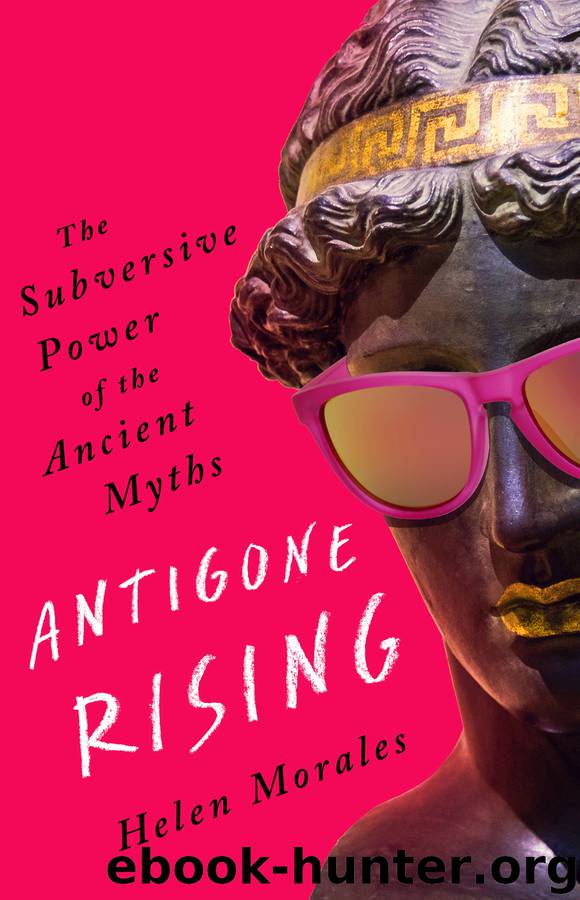Antigone Rising: The Subversive Power of the Ancient Myths by Helen Morales

Author:Helen Morales [Morales, Helen]
Language: eng
Format: epub
ISBN: 9781472273628
Google: 9AS-DwAAQBAJ
Publisher: Headline
Published: 2020-04-13T23:00:00+00:00
Diana, or, as the Greeks called her, Artemis, has come back in vogue in New Age feminism and in popular culture. These Dianas range from sanitized versions of the goddess to more powerful avatars.
Jean Shinoda Bolen, Jungian psychiatrist and author of the classic Goddesses in Everywoman (first issued in 1985) published Artemis: The Indomitable Spirit in Everywoman (2014), in which she argues that Artemis is the archetype of the courageous girl and woman, the one who perseveres and survives. As Gloria Steinem puffs on the back of the book: “Artemis is the archetype or goddess who can inspire us to be activists in the world.” Shinoda Bolen compares the traits of the goddess to the stories and lives of strong women, real and fictional. What we get is Diana diluted, a goddess who stands for any woman who might be described as ballsy and courageous: Cheryl Strayed, Diana Nyad, Sheryl Sandberg, Elisabeth Smart, Malala Yousafzai, Eve Ensler. Katniss Everdeen, heroine of The Hunger Games trilogy, apparently embodies the same Artemisian independence and courage as Lisbeth Salander from Stieg Larsson’s The Girl with the Dragon Tattoo series and Anastasia Steele from E. L. James’s Fifty Shades of Grey books. Holy crap! as Lisbeth Salander would never say.
Another novel, written by Martha Beck, life coach and writer for O Magazine, was published in 2016. Diana, Herself: An Allegory of Awakening is a novel about a struggling single mother called Diana Archer (allegories are not subtle), who discovers herself when she journeys into the wilderness and learns how to use a bow and arrow and also how to listen to her intuition and to the world. Beck has a knack for capturing the serious through the absurd (the guru figure in the novel is a talking wild boar), and Diana, Herself is a parable of enlightenment that makes use of the motifs and qualities of the goddess Diana. At the heart of the magical tale, however, is a kernel of more subversive wisdom. Liberation only comes—for herself and for the earth—when Diana destroys patriarchy (I won’t say how, but if you’ve never warmed to TV star survivalists, then this is the book for you).
In her book Hunting Girls: Sexual Violence from The Hunger Games to Campus Rape (2016), Kelly Oliver discusses a new trend in popular culture to represent girls as hunters, for example Katniss Everdeen, Bella Swan (Twilight), Tris Prior (Divergent), and Hanna (Hanna). She argues this trend is a response to an increase in violence toward girls and women: “New myths of Artemis figures defending their own virtue from the violence all around them can be interpreted as compensatory fantasies for girls and women subjected to violence, especially sexual violence, in their everyday lives.”16
These new Artemis figures stop short, however, of doing what the real-life kick-ass heroine Diana, the Hunter of Bus Drivers does: enact revenge. Corporatized feminism does not have much time for revenge. Revenge has greater visibility as a lifestyle product than it does as an issue in feminist theory.
Download
This site does not store any files on its server. We only index and link to content provided by other sites. Please contact the content providers to delete copyright contents if any and email us, we'll remove relevant links or contents immediately.
On the Front Line with the Women Who Fight Back by Stacey Dooley(4312)
The Lonely City by Olivia Laing(4121)
The Rules Do Not Apply by Ariel Levy(3907)
Bluets by Maggie Nelson(3713)
The Confidence Code by Katty Kay(3568)
Three Women by Lisa Taddeo(2921)
Inferior by Angela Saini(2833)
A Woman Makes a Plan by Maye Musk(2832)
Pledged by Alexandra Robbins(2792)
Not a Diet Book by James Smith(2727)
Confessions of a Video Vixen by Karrine Steffans(2675)
Nice Girls Don't Get the Corner Office by Lois P. Frankel(2594)
Wild Words from Wild Women by Stephens Autumn(2589)
Brave by Rose McGowan(2503)
The Girl in the Spider's Web: A Lisbeth Salander novel, continuing Stieg Larsson's Millennium Series by Lagercrantz David(2381)
The Clitoral Truth: The Secret World at Your Fingertips by Rebecca Chalker(2244)
Why I Am Not a Feminist by Jessa Crispin(2240)
Women & Power by Mary Beard(2225)
Women on Top by Nancy Friday(2123)
